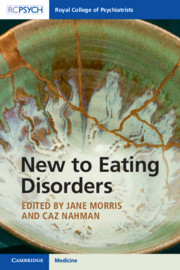Book contents
- New to Eating Disorders
- New to Eating Disorders
- Copyright page
- Contents
- Foreword
- Acknowledgements
- Introduction for Trainees and Students
- Chapter 1 What Are Eating Disorders?
- Chapter 2 Causes and Formulation
- Chapter 3 The Carer’s Perspective
- Chapter 4 Risk Assessment and Management
- Chapter 5 Ethical and Medico-legal Issues
- Chapter 6 Management of Eating Disorders
- Chapter 7 Nutritional Care: Dietetic Interventions Including Behavioural Interventions
- Chapter 8 Exercise and Activity
- Chapter 9 Body Image
- Chapter 10 Severe and Enduring Eating Disorders
- Chapter 11 Children and Adolescents
- Chapter 12 Transitions
- Index
- References
Chapter 1 - What Are Eating Disorders?
Published online by Cambridge University Press: 12 June 2020
- New to Eating Disorders
- New to Eating Disorders
- Copyright page
- Contents
- Foreword
- Acknowledgements
- Introduction for Trainees and Students
- Chapter 1 What Are Eating Disorders?
- Chapter 2 Causes and Formulation
- Chapter 3 The Carer’s Perspective
- Chapter 4 Risk Assessment and Management
- Chapter 5 Ethical and Medico-legal Issues
- Chapter 6 Management of Eating Disorders
- Chapter 7 Nutritional Care: Dietetic Interventions Including Behavioural Interventions
- Chapter 8 Exercise and Activity
- Chapter 9 Body Image
- Chapter 10 Severe and Enduring Eating Disorders
- Chapter 11 Children and Adolescents
- Chapter 12 Transitions
- Index
- References
Summary
This chapter briefly summarises some of the causes of eating disorders and introduces the reader to the concept of bio-psycho-social formulation and how to develop a formulation with the patient, looking at predisposing factors, precipitation (trigger) factors, and maintaining factors within an eating disorder.
- Type
- Chapter
- Information
- New to Eating Disorders , pp. 1 - 7Publisher: Cambridge University PressPrint publication year: 2020

